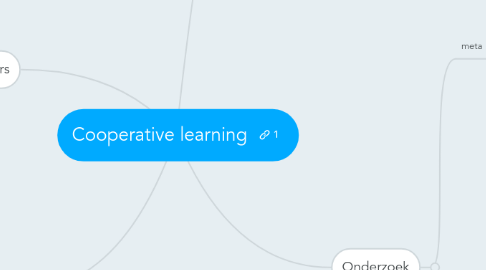
1. Methods
1.1. Learning Together (LT)
1.2. Academic Controversy (AC)
1.3. Student-Team- Achievement-Divisions (STAD)
1.4. Teams-Games-Tournaments (TGT)
1.5. Group Investigation (GI)
1.6. Jigsaw
1.7. Teams-Assisted-Individualization (TAI)
1.8. Cooperative Integrated Reading and Composition (CIRC)
2. Onderzoek
2.1. meta
2.1.1. Johnson, D. W., Johnson, R. T., & Stanne, M. B. (2000). Cooperative learning methods: A meta-analysis.
2.1.1.1. Alle coooperative learning is positief maar soms weinig meerdwaarde tov competatief
2.1.1.2. Conceptual methods
2.1.1.2.1. docenten hebben diepe kennis van CL en er ontstaat een aantoonbaar hogere achievement outcome
2.1.1.3. Direct methods
2.1.1.3.1. snel aan te leren maar weinig effect op achievement outcome
2.1.1.4. Top 3 effectieve methodes CL
2.1.1.4.1. 1 Learning Together
2.1.1.4.2. 2 Acedemic controversy
2.1.1.4.3. 3 Group investigation
2.1.2. Slavin, R. E. (2015). Cooperative learning in elementary schools. Education 3-13, 43(1), 5-14. doi:10.1080/03004279.2015.963370
2.1.2.1. Complementary methods/types/theories of CL
2.1.2.1.1. Motivationalist
2.1.2.1.2. Social cohesion
2.1.2.1.3. Cognitive Developmental
2.1.2.1.4. Cognitive Elaboration
2.2. nederlands
2.2.1. Veenman, S., Kenter, B., & Post, K. (2010). Cooperative Learning in Dutch Primary Classrooms. Educational Studies, 26(3), 281-302. doi:10.1080/03055690050137114
2.2.1.1. lesobservatie
2.2.1.1.1. Ros
2.2.1.1.2. methoden geobserveerd (Kagan)
2.2.1.1.3. weinig gebruik van van 5 basis ingredienten van Johnson en Johnson
2.2.1.2. vragenlijst docenten
2.2.1.3. vragenlijst studenten
2.2.1.4. uitkomst:
2.2.1.4.1. In general, the quantitative and qualitative aspects of the present study show the practices followed by Dutch teachers for the implementation of CL to be inconsistent with the features of effective CL promoted in the literature.
2.2.2. Veenman, S., van Benthum, N., Bootsma, D., van Dieren, J., & van der Kemp, N. (2002). Cooperative learning and teacher education. Teaching and Teacher Education, 18(1), 87-103.
3. auteurs
3.1. Slavin
3.1.1. The free rider effect (or so-called social loafing) can be eliminated by making each group member responsible for a unique part of the group’s task and pupils individually accountable for their learning
3.2. Johnson en Johnson
3.2.1. 5 Basic Elements
3.2.1.1. Positive interdependence
3.2.1.2. Individual Accountability
3.2.1.3. Face-to-Face interaction
3.2.1.4. Social skills
3.2.1.5. Group processing
3.3. Kagan
3.3.1. = Direct methods
3.3.2. 100 en meer structuren bedacht voor ccoperatief leren (weinig onderzoek te vinden)
